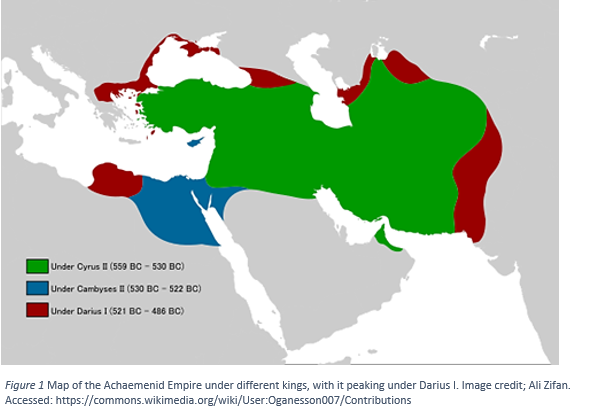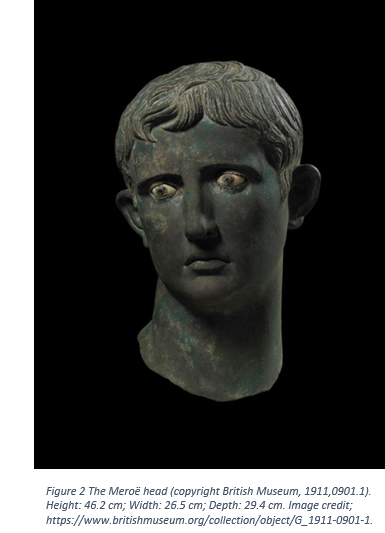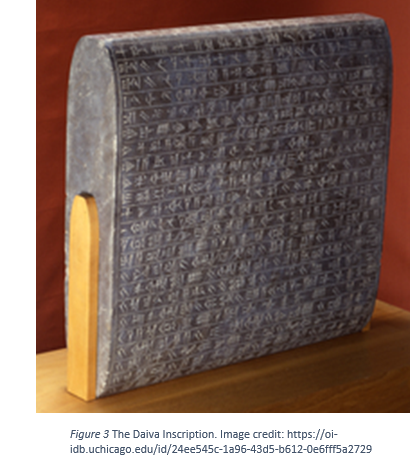2022/2023 WCN Student Blog - Áine Nikookam

Hello and welcome!
I'm Áine, a second-year Classical Civilisation student here at the University of Warwick.
If you are looking to learn something new or find out more about Classics as a subject, you're on the right site! I will be posting about what it's like as a student studying Classics at Warwick, along with some more academic (but easy to follow) aspects of the ancient world that I find interesting, such as the Augustan Age and the Achaemenid Empire (ancient Persia).
If you have any questions or would like to reach out, please don't hesitate to contact me at: Aine.Nikookam@warwick.ac.ukLink opens in a new window
Beyond the books: the significance of material culture
18th November 2021
I always thought that Classical Civilisation was best described as a mix of History, English, Drama and Languages (with a few vases thrown in) while I was studying it in sixth form. Once I enrolled into university, however, I quickly realised how one-dimensional that view is. I never used to give material evidence much appreciation, not being able to see the point in studying coins, vases, archaeological remains, trinkets etc., but now I cannot imagine studying this degree without it.
 What really changed the way I viewed the ancient world was Warwick’s Stories of Objects module that ran this summer. It focused solely on material culture and our assessments consisted of a blog post on an object of our choosing, and the formation of your own exhibition with a limit of five objects. The aim of the exhibition was to tell a story about a certain period in the ancient world through five objects. The module gave us complete control over what areas of the ancient world we wanted to study and write about, and I took this as an opportunity to focus on something new. I stepped away from the Ancient Greeks and Romans, civilisations we are predominantly exposed to in schools and universities, and instead focused on the Achaemenid Empire (a Persian Empire that flourished between 559-331 BCE (left)) and the Kingdom of Kush (a Nubian Empire that thrived from 1069 BCE to 350 CE).
What really changed the way I viewed the ancient world was Warwick’s Stories of Objects module that ran this summer. It focused solely on material culture and our assessments consisted of a blog post on an object of our choosing, and the formation of your own exhibition with a limit of five objects. The aim of the exhibition was to tell a story about a certain period in the ancient world through five objects. The module gave us complete control over what areas of the ancient world we wanted to study and write about, and I took this as an opportunity to focus on something new. I stepped away from the Ancient Greeks and Romans, civilisations we are predominantly exposed to in schools and universities, and instead focused on the Achaemenid Empire (a Persian Empire that flourished between 559-331 BCE (left)) and the Kingdom of Kush (a Nubian Empire that thrived from 1069 BCE to 350 CE).
 The Meroë Head (right) was the focal point of my blog post, a decapitated head from a toppled statue of Augustus in the late 1st century BCE that Kushites buried under the steps of a temple to Victory in Meroë. A closer inspection of the head’s ancient history, the history of its excavation, and its current display in the British Museum along with recent events surrounding the Black Lives Matter movement, I quickly realised how black voices have been suppressed throughout its history. That realisation was my ‘eureka!’ moment; I understood how a singular object can provide such a rich history and how I was studying objects in the complete wrong way. It’s what made me recognise how we should be asking ourselves the ways ancient objects benefit us today – what we can learn from them, how we can recontextualise them by uncovering the intentions behind their creation, and how that recontextualization fits in with our modern understandings of the ancient world.
The Meroë Head (right) was the focal point of my blog post, a decapitated head from a toppled statue of Augustus in the late 1st century BCE that Kushites buried under the steps of a temple to Victory in Meroë. A closer inspection of the head’s ancient history, the history of its excavation, and its current display in the British Museum along with recent events surrounding the Black Lives Matter movement, I quickly realised how black voices have been suppressed throughout its history. That realisation was my ‘eureka!’ moment; I understood how a singular object can provide such a rich history and how I was studying objects in the complete wrong way. It’s what made me recognise how we should be asking ourselves the ways ancient objects benefit us today – what we can learn from them, how we can recontextualise them by uncovering the intentions behind their creation, and how that recontextualization fits in with our modern understandings of the ancient world.
This inspired the narrative behind my exhibition portfolio, which was to use the concept of Greek ‘otherness’ (meaning the quality of being ‘different’ – a stigmatisation based on differences of identity) to study the Achaemenids in a Persian context. A large proportion of literary evidence about the Persians from the Achaemenid Period comes from Greek authors, such as Herodotus’ Histories and Aeschylus’ Persians. This means that if we study the Achaemenids primarily using literary sources, we will get a one-dimensional, biased view. This is due to the political affairs of the time having a large influence on the Greeks’ representation of the Persians, such as the Greco-Persian Wars (a series of conflicts that spanned from 492 to 449 BCE). However, I was able to discover how the Persians flourished under their kings, despite their Greco-Persian War losses, and that they were an empire that contained multiple cultures that interacted with and embraced each other.
One of the most vital aspects in forming my narrative successfully was to obtain a range of objects from different periods within the Achaemenid era. Furthermore, each of the five objects had to represent a different aspect of Achaemenid ideology and beliefs, which allowed me to ensure I effectively encapsulated who they were and how such a great empire fruitfully functioned under the rule of a monarch. My first two objects, the Cyrus Cylinder and  the Daiva inscription, (right) were used to represent the best and the worst aspects of the empire respectively when it comes to tolerance. Cyrus (the first king of the Achaemenid Empire 550-530 BCE) established himself as a benevolent ruler that willingly adopted cultural practices of civilisations within the empire. On the other hand, the Daiva Inscription of Xerxes I (fourth king of the empire 486-465 BCE) demonstrates how little care he had for the people of his empire, prohibiting them from worshipping their own gods. These two objects were highly beneficial in implementing an understanding of the usefulness of inscriptions in terms of showcasing who the kings were as people (one wanting peace, and the other causing problems), and how they wished to display themselves to the empire, and the beliefs and ideologies they wished to be adopted by the empire.
the Daiva inscription, (right) were used to represent the best and the worst aspects of the empire respectively when it comes to tolerance. Cyrus (the first king of the Achaemenid Empire 550-530 BCE) established himself as a benevolent ruler that willingly adopted cultural practices of civilisations within the empire. On the other hand, the Daiva Inscription of Xerxes I (fourth king of the empire 486-465 BCE) demonstrates how little care he had for the people of his empire, prohibiting them from worshipping their own gods. These two objects were highly beneficial in implementing an understanding of the usefulness of inscriptions in terms of showcasing who the kings were as people (one wanting peace, and the other causing problems), and how they wished to display themselves to the empire, and the beliefs and ideologies they wished to be adopted by the empire.
However, the most important characteristic I wished to display in different context was the idea of the Achaemenids being a multicultural empire. My final three object were a gold fluted bowl from 6th-5th century BCE, a gold necklace with the Egyptian god Bes as its central image from 6th-4th century BCE, and a silver statuette of a naked youth from the Oxus Treasure 5th century BCE. This fluted bowl was used as a way for the elite to demonstrate how multicultural they were as it had an inscription naming Darius the Great as king under the rim in three different languages: Persian, Elamite, and Babylonian. Moreover, the gold necklace was found in Iran, demonstrating how cultures within the empire influenced each other through interactions. Bes was a dwarf deity of childbirth and a protector, closely resembling the Iranian deity Mithra, thus we see Bes being completely adopted and manifested in an Iranian context whilst also maintaining its Egyptian connotations. The silver statuette, however, is the most interesting and controversial object of the three, resembling 5th century BCE Greek votive figures. The statuette’s nudity is what makes it so scandalous as the Achaemenids had a distaste for nudity, thus stressing how the heightened interactions between the Greeks and Persians from this period onwards must have led to more Greek-styled art.1
We would have never reached these conclusions from studying the Persians purely from literary sources. Without taking material evidence into account, it would be impossible to learn about the messages behind these objects which give us clear evidence on themes such as religion, class, human rights, societal norms, and cultural tolerance of the Achaemenids. Fortunately, methods of studying Classics are continually changing and adapting, and it is important for us to ensure we develop a mindset for a deeper appreciation of material culture and arts. Moreover, it makes Classics more accessible for all students as there are aspects that would satisfy all, instead of being stuck with the archaic modes of teaching and learning with literary sources.
So, tell me, how will you be incorporating material sources in the study of Classics in the future?
Work cited:
- Abdi, K. (2002), ‘Notes on the Iranianisation of Bes in the Achaemenid Empire’, Ars Orientalis, 32, pp. 133-162.
